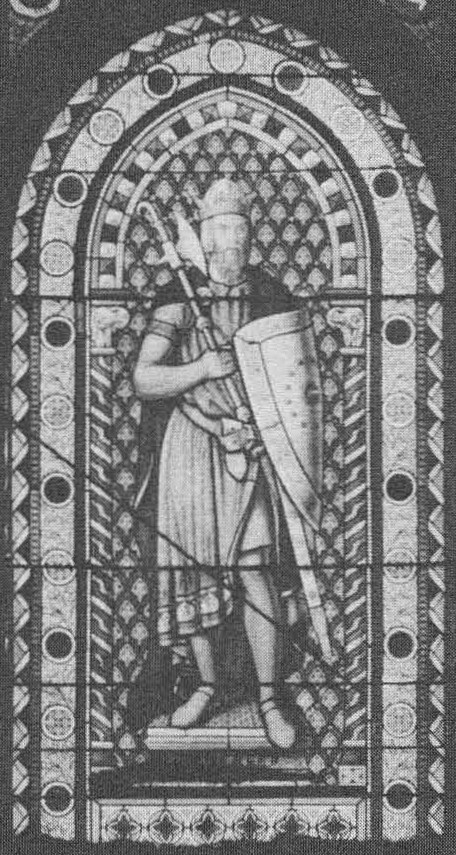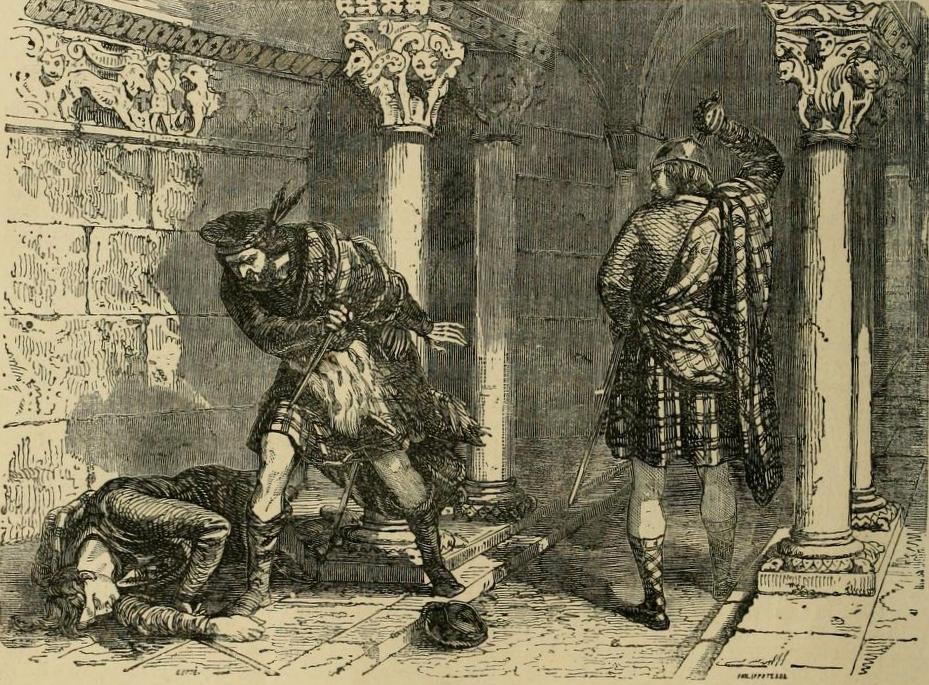The Remarkable Clan MacDougall Chiefs and Their Contribution
by Aimee Li on Aug 01, 2024
Table of Content
I. Introduction
1. The Origin of Clan MacDougall
Clan MacDougall's name comes from Dougall, son of Somerled. After Somerled died in 1164, Dougall took control of much of Argyll and several islands, including Mull, Lismore, Jura, Tiree, and Coll. The name Dougall, or Dugald, comes from the Gaelic term "dubh-gall", which translates to "black stranger." The King of Norway acknowledged Dougall as the 'King of the South Isles and Lord of Lorne.' His son, Óspakr-Hákon, was appointed King of the Isles in 1230 by the Norwegian King Hákon Hákonarson.

Dougall's son Duncan fathered Ewan, and together they built several castles, including Dunstaffnage, Dunollie, and Duntrune on the mainland and Aros, Cairnburgh, Dunchonnel, and Coeffin on the islands. Dunollie Castle, fortified since the 6th century, was the principal seat of Clan MacDougall. Duncan also founded Ardchattan Priory, the burial ground for MacDougall chiefs until 1737.
2. Brief of Clan MacDougall History
After Somerled died in 1164, his son Dougall became the senior King of Dalriada. By 1244, the MacDougall name had established itself as a clan. Descendants of Dougall built notable castles, including Dunstaffnage and Dunollie on the shores of Loch Linnhe and Duntrune on the mainland. They built Aros, Coeffin, Dunchonnel, and Cairnburgh on the islands. They also constructed Ardchattan Priory, the burial ground for MacDougall chiefs until 1737, with Ewan endorsing most of these projects.

Ewan managed to keep his island possessions from the Norwegian King. He tried to protect his mainland properties from the Scottish King. When King Haakon of Norway attempted an invasion in 1263, Ewan surrendered his islands but later attacked part of the Norse fleet. After Haakon's defeat at the Battle of Largs, Norway returned the Hebrides to Scotland three years later. Alistair MacDougall married the sister of John Comyn, an influential Scottish figure. John's son, the Red Comyn, was next in line for the throne after the Balliols. However, Bruce's ambition led him to kill the Red Comyn, sparking a feud that ended with the destruction of the Comyns and the loss of the MacDougalls' islands to Bruce.
⚡ Learn more about the history of Clan MacDougall at Explore Clan MacDougall History: Legends and Ancestral Tales
II. Clan MacDougall Chiefs: Prominent Leaders and Their Contribution
1. Dougall MacSomairle, King in the (Hebrides) Isles (1164 – d. 1207)
The eponymous founder of Clan MacDougall was born around 1140. He was the son of Somerled, King of the Hebrides, and Regulus of Argyll, and his mother was Raghnild, daughter of Olaf, King of Man. The name Dougal, derived from Gaelic, means "Black Foreigner," referring to a Dane or Norseman. By the mid-12th century, those with this name had likely Norse ancestry; both his mother and great-grandmother were of Norse descent. Dougall was first mentioned in the Chronicle of Man when island chieftains invited him to be their King in 1155, leading to a sea battle in January 1156 that resulted in a territorial agreement between his family and Godfrey.
After his father's and older stepbrother's deaths at the Battle of Renfrew in 1164, Dougal inherited Somerled's mainland kingdom, which included multiple islands and significant forts. This territory, known as Ergadia, was held by his successors for another 150 years until 1308. During this time, most of the Hebrides belonged to Norway while the mainland was under Scottish control, making the MacDougall Chiefs vassals of two rival kings. Dougall inherited these dual kingships, while his younger brothers received the remaining lands: Reginald got Islay and Kintyre, and Angus received Bute. Dougal supported the Abbey on Iona and its daughter monasteries during his lifetime.

2. Duncan de Ergadia (of Argyll), and King in the (Hebrides) Isles (d. 1207 – d. 1247)
Duncan, the second chief of the clan and son of Dougall, appears in records with his family in 1175. In Norse sagas, King Duncan governed Argyll as a vassal under the King of Scots from 1222. He was also King of the Isles under the King of Norway, except from 1230 to 1232 when his brother Uspak took over. In 1225, Duncan signed a charter as Duncan de Ergadia, a title granted by King Alexander II.

By 1228, conflicts led the King of Norway to appoint Uspak as overlord of the Isles. Uspak replaced Duncan, but after Uspak's death around 1231 or 1232, Duncan regained control. He founded Ardchattan Priory between 1230 and 1231 and likely built several MacDougall castles, including possibly Dunstaffnage.
3. Ewan de Ergadia (of Argyll), King in the (Hebrides) Isles, and Lord of Lorn (1247 – d. 1265 or 1266)
Ewan, the Third Chief of his clan and son of Duncan, the Second Chief, known as King John in Norse sagas, sought kingship in Norway in 1247-1248. By summer 1248, King Hakon of Norway appointed him King of the Isles while he remained a vassal to Scottish King Alexander II. Ewan controlled key castles like Dunstaffnage and Dunollie, holding significant sway.
Tensions between Norway and Scotland strained Ewan, torn by his feudal loyalties. In 1249, Alexander II's invasion halted due to his sudden death, shifting power to his young son, Alexander III. Ewan regained control of Argyll in 1255 after spells in the Isle of Man and Bergen. In 1263, King Hakon detained Ewan briefly amid Scottish raids, leading Ewan to renounce his kingship and side with Scotland. The Treaty of Perth in 1266 confirmed Scotland's authority over the Hebrides, securing Ewan's island holdings.
4. Sir Alexander de Ergadia (of Argyll), Lord of Lorn (1266- d. 1309)
Fourth Chief of the clan and son of Ewan. Known as Alasdair de Ergadia, he married Julienne Comyn and aligned with prominent families. His sister Mary also made influential alliances, including Magnus, King of the Isle of Man. Alexander engaged in trade with Ireland, suppressed a revolt in 1275, and supported John Baliol in 1292. As Sheriff of Argyll, he faced challenges from the Clan Campbell and suffered losses in the Battle of Allt Dearg (The Red Ford) around 1294-1296.

Alexander supported Baliol against Edward I but was imprisoned from 1296 to May 1297. He raided Clan Donald's territory and killed their Chief in 1299. By 1301, he was part of Edward I's advisory council. However, after Robert the Bruce murdered John the Red Comyn, Alexander, who had no obligation to support Bruce, sided with Edward I. Though his son John led a successful ambush against Bruce in 1306, Alexander lost his Lordship and lands after the Battle of Brander in 1308. He fled abroad and likely died in Ireland in late 1310, and Ewan became the last MacDougall Lord of Lorn.
5. Colonel Alexander James of Dunollie (1899 – d. 1953)
The twenty-ninth Chief of Clan MacDougall, and was the son of the twenty-eighth Chief, Henry Robert Lawrence of Dunollie. He earned an M.B. and Ch. B. from the University of Edinburgh rose to Colonel in the Royal Army Medical Corps. In World War I, he served as part of the first British Expeditionary Force to Europe in 1914. He was mentioned in dispatches twice and was appointed Commander of Saint Michael and Saint George. During World War II, he served in the Home Guard and worked as a welfare officer. A strong supporter of youth organizations, he was also profoundly interested in the clan's heritage. He married Colina Edith, daughter of Alexander MacDougall of Soroba.
6. Morag Morley MacDougall of MacDougall and Dunollie (1990)
The present leader of the clan is Morag Morley MacDougall of MacDougall and Dunollie. She is the child of the sister of the previous clan chief, Coline Helen Elizabeth MacDougall of MacDougall and Dunollie. The Chief of Clan MacDougall signifies the central lineage of Somerled's heirs.

III. Conclusion
In conclusion, the role of the Clan MacDougall Chief is not just a title but a significant legacy that embodies the history and traditions of one of Scotland's storied clans. As the Chief, their responsibility extends beyond mere leadership; it involves preserving the clan's rich heritage, fostering unity among members, and upholding the values that have defined the MacDougall lineage for centuries. The Clan MacDougall Chief symbolizes continuity and pride, bridging the past with the present and ensuring that the clan's illustrious history remains a guiding light for future generations.
Frequently Asked Questions
What clan does McDougall belong to?
The MacDougall clan is a Highland clan that derives its name from Dougall, the son of the warlord Somerled. Following his father's demise, Dougall possessed a significant expanse of land in Argyll, located on the western coast of Scotland.
What is the motto of the MacDougall clan?
Buaidh no bàs (Victory or Death), also translated as "Conquer or Die."
What is the Clan MacDougall flower?
Bell Heather
Clan MacDougal emblem is the Bell Heath (Erica Cinerea), characterized by its large, crimson-purple blooms that grow in terminal clusters. The stems are rich red, while the needle-shaped leaves are vibrant green.
What is the history of the name MacDougall?
The English version of the Gaelic name Mac Dubhghaill, which means 'son of Dubhghall,' combines the elements dubh, meaning 'black,' and gall, meaning 'stranger.' Initially, this nickname was created to differentiate the darker-haired Danes from the lighter-haired Norwegians.







